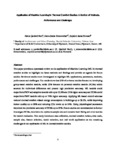Application of machine learning in thermal comfort studies: A review of methods, performance and challenges
| dc.contributor.author | Qavidel Fard, Z | |
| dc.contributor.author | Zomorodian, ZS | |
| dc.contributor.author | Korsavi, Sepideh Sadat | |
| dc.date.accessioned | 2022-01-06T16:04:37Z | |
| dc.date.available | 2022-01-06T16:04:37Z | |
| dc.date.issued | 2022-02 | |
| dc.identifier.issn | 0378-7788 | |
| dc.identifier.issn | 1872-6178 | |
| dc.identifier.other | 111771 | |
| dc.identifier.uri | http://hdl.handle.net/10026.1/18534 | |
| dc.description.abstract |
This paper provides a systematic review on the application of Machine Learning (ML) in thermal comfort studies to highlight the latest methods and findings and provide an agenda for future studies. Reviewed studies were investigated to highlight ML applications, parameters, methods, performance and challenges. The results show that 62% of reviewed studies focused on developing group-based comfort models, while 35% focused on personal comfort models (PCMs) which account for individual differences and present high prediction accuracy. ML models could outperform PMV and adaptive models with up to 35.9% and 31% higher accuracy and PCMs could outperform PMV models with up to 74% higher accuracy. Applying ML-based control schemas reduced thermal comfort-related energy consumption in buildings up to 58.5%, while improving indoor quality up to 90% and reducing CO2 levels up to 24%. Using physiological parameters improved the prediction accuracy of PCMs up to 97%. Future studies are recommended to further investigate PCMs, determine the optimum sample size and consider both fitting and error metrics for model evaluation. This study introduces data collection, thermal comfort indices, time scale, sample size, feature selection, model selection, and real world application as the remaining challenges in the application of ML in thermal comfort studies. | |
| dc.format.extent | 111771-111771 | |
| dc.language | en | |
| dc.language.iso | en | |
| dc.publisher | Elsevier BV | |
| dc.rights | Attribution 4.0 International | |
| dc.rights | Attribution 4.0 International | |
| dc.rights | Attribution 4.0 International | |
| dc.rights | Attribution 4.0 International | |
| dc.rights.uri | http://creativecommons.org/licenses/by/4.0/ | |
| dc.rights.uri | http://creativecommons.org/licenses/by/4.0/ | |
| dc.rights.uri | http://creativecommons.org/licenses/by/4.0/ | |
| dc.rights.uri | http://creativecommons.org/licenses/by/4.0/ | |
| dc.subject | Thermal comfort | |
| dc.subject | Machine learning | |
| dc.subject | Group-based models | |
| dc.subject | Personal comfort models | |
| dc.subject | Performance | |
| dc.subject | Prediction accuracy | |
| dc.title | Application of machine learning in thermal comfort studies: A review of methods, performance and challenges | |
| dc.type | journal-article | |
| dc.type | Review | |
| dc.type | Journal | |
| plymouth.author-url | https://www.webofscience.com/api/gateway?GWVersion=2&SrcApp=PARTNER_APP&SrcAuth=LinksAMR&KeyUT=WOS:000754031200003&DestLinkType=FullRecord&DestApp=ALL_WOS&UsrCustomerID=11bb513d99f797142bcfeffcc58ea008 | |
| plymouth.volume | 256 | |
| plymouth.publication-status | Published | |
| plymouth.journal | Energy and Buildings | |
| dc.identifier.doi | 10.1016/j.enbuild.2021.111771 | |
| plymouth.organisational-group | /Plymouth | |
| plymouth.organisational-group | /Plymouth/Faculty of Arts, Humanities and Business | |
| plymouth.organisational-group | /Plymouth/Faculty of Arts, Humanities and Business/School of Art, Design and Architecture | |
| plymouth.organisational-group | /Plymouth/Users by role | |
| plymouth.organisational-group | /Plymouth/Users by role/Academics | |
| dcterms.dateAccepted | 2021-12-07 | |
| dc.rights.embargodate | 2022-12-11 | |
| dc.identifier.eissn | 1872-6178 | |
| dc.rights.embargoperiod | Not known | |
| rioxxterms.versionofrecord | 10.1016/j.enbuild.2021.111771 | |
| rioxxterms.licenseref.uri | http://creativecommons.org/licenses/by/4.0/ | |
| rioxxterms.licenseref.startdate | 2022-02 | |
| rioxxterms.type | Journal Article/Review |



